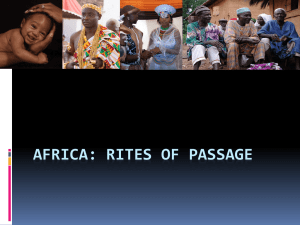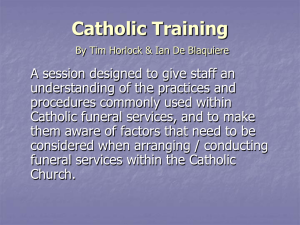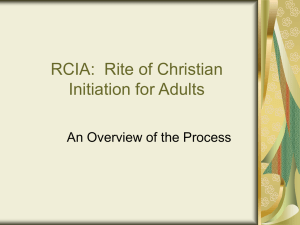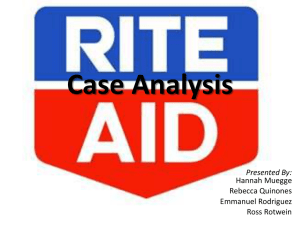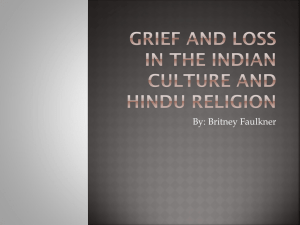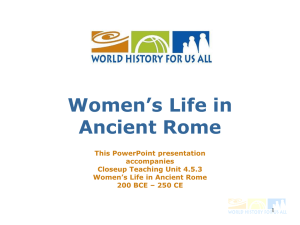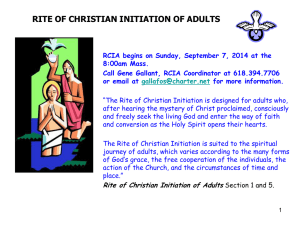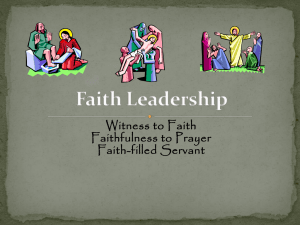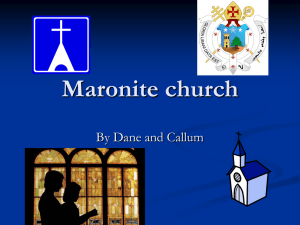The Rites of the Catholic Church
advertisement
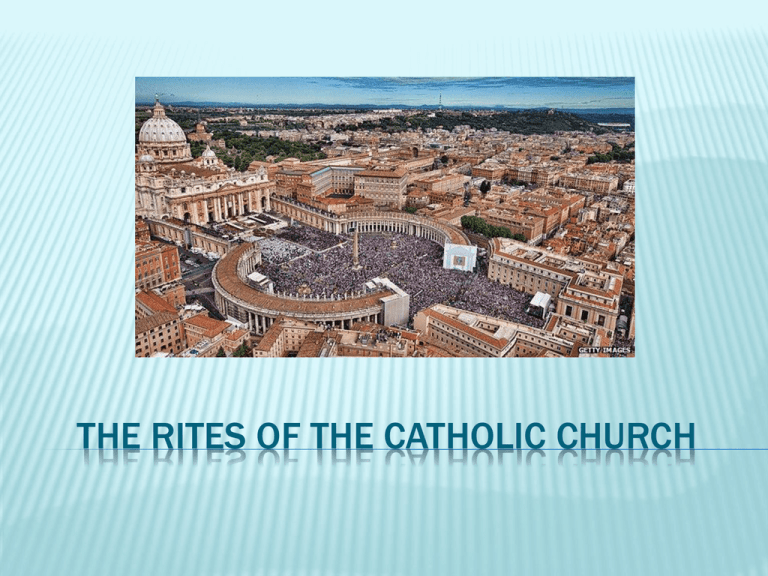
THE RITES OF THE CATHOLIC CHURCH EASTERN CATHOLIC CHURCHES Unity in diversity Some differing practices and rituals, but still in full communion with Rome ~21 Eastern Catholic Churches (some use the same rites) Most separated from the Roman Catholic Church during the 11th century schism, but then returned, so they are in full communion with Rome RITES OF THE CATHOLIC CHURCH A rite represents an ecclesiastical tradition about how the Sacraments are to be celebrated. As the early Church grew and spread, it celebrated the Sacraments as would be best understood and received in the context of individual cultures, without ever changing their essential form and matter. Rites Based on Culture The early Church sought to evangelize in the major cultural centers of the first centuries A.D. : • Rome, Antioch (Syria), and Alexandria (Egypt) All the rites in use today evolved from the liturgical practices and ecclesiastical organization used by the churches in these cities. THE RITES OF THE CATHOLIC CHURCH The Catechism of the Catholic Church lists seven rites. These rites: Latin, Byzantine, Alexandrian, Syriac, Armenian, Maronite, and Chaldean, are actually families of liturgical expression. THE RITES OF THE CATHOLIC CHURCH ROME Latin (Roman) ANTIOCH Byzantine Mozarabic Ambrosian Bragan Dominican Carmelite Carthusian Syriac Armenian Maronite Chaldean Syro-Malabar ALEXANDRIA Alexandrian Coptic Ethiopian LATIN (ROMAN) RITE As the Bishop of Rome the Pope is the head of the Latin or Roman rite. This is by far the largest rite in the Church. The current Eucharistic liturgy was handed down more or less intact from at least the 4th century. The Pope is also vicar of these other liturgical rites that date from before the Council of Trent: the Mozarabic rite from Spain, the Ambrosian rite from Milan, the Bragan rite from Portugal, and the order liturgies of the Dominican, Carmelite, and Carthusian orders. BYZANTINE RITE The largest of the eastern rites is the Byzantine. The Byzantine liturgy is based on the liturgy developed by St. James, modified by St. Basil (329-379) and St. John Chrysostom (344-407). This liturgy is VERY similar to the liturgy used by the Orthodox churches. The churches using the Byzantine liturgy include: Albanian Belarussian Bulgarian Croatian Greek Hungarian Italo-Albanian Melkite Romanian Russian Ruthenian Slovak Ukrainian ALEXANDRIAN RITE The liturgy used by the church in Alexandria in Egypt is attributed to St. Mark the Evangelist. This church became known as the Coptic church, as “Copt” is derived from the Arabic and Greek word for Egyptian. The Ethiopian (Ge'ez) rite is closely associated with the Coptic rite. Missionaries from Alexandria spread the faith in Ethiopia in the 4th century. The native language (Ge'ez) was used instead of Greek in the liturgy. SYRIAC RITE The liturgy of the Syriac rite is attributed to St. James the Apostle. This liturgy was used by the church in Antioch, which is in present day Turkey, just outside of Syria. ARMENIAN RITE Armenia used the Antiochian liturgy of St. James, prayed in the Armenian language. Armenia was located in Turkey. The Turks massacred roughly two million Armenians at the end of World War I. Today most members of this rite live in Lebanon. MARONITE RITE The Maronite rite traces its origins to the work of St. Maron in the 4th century who founded a monastery near Antioch. Later, monks moved to the mountains in what is today Lebanon. The Maronites use a hybrid liturgy based on the Antiochian St. James. Maronites make up about 22% of the population of Lebanon, and by the law, the president is always a Maronite. CHALDEAN RITE The people in modern day Iran and Iraq were once known as the Assyrians. The Church established itself there very early. Chaldean is the biblical term used for those from Babylon. Today the Patriarch of this rite is located in Bagdad, Iraq where most of the members of this rite live*. * SYRO-MALABAR RITE The Malabar rite is based in India. Its members are descendants of the St. Thomas Christians. The Malabar rite is generally grouped with the Chaldean family of rites because the Assyrian (later called Chaldean) church provided their bishops until the Portuguese took over that task. Their liturgy was originally in the Syriac language which the Chaldean church used. SUMMARY All the rites of the Catholic Church are of equal dignity and equally valid. Attendance at a different rite fulfills the Sunday obligation. The Catholic Church is truly universal (catholic) since it unites so many diverse rites, whose members share a common faith. Main Source NOTE: EASTERN CATHOLIC ≠ EASTERN ORTHODOX EASTERN CATHOLIC churches are in full communion with Rome EASTERN ORTHODOX churches are not in communion with Rome (but we have great hope!)
